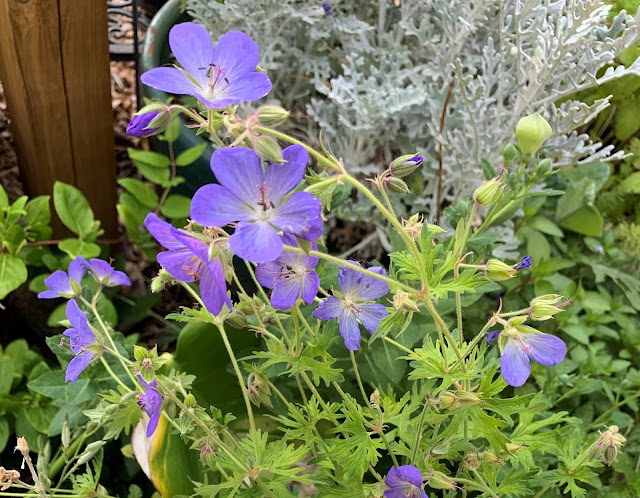Indoors or Outdoors? Bringing Plants Indoors May Do More Harm Than Good
Southwest Yard & Garden
by Dr. Marisa Thompson
‘Johnson’s blue’ geranium thriving
in a pot in June 2020, after spending the previous two winters outdoors. Photo
credit Marisa Thompson.
Question: Should I bring my potted trees and shrubs inside
for the winter? I have a willow tree, a poplar tree, and a berry bush, and I
live at 7,300 ft.
-
Ora N., Seed to Supper Participant
Answer: As we all hunker down for winter, I’ve gotten several
questions about which plants to protect from the cold and how to do it. Are
plants safer in the home, in a greenhouse-type structure, in a pot, or planted
in the ground?
Let’s start with your location and data from winters past. Find the most current USDA plant hardiness zone map at https://planthardiness.ars.usda.gov/. Enter your address in the search prompt, and a little box pops up with your “plant hardiness zone” based on the average coldest annual temperatures between 1976 and 2005. Mine in Los Lunas is 7a, which means that extreme low temps in my area averaged between 0°F to 5°F during that period.
Next, look up the cold hardiness of each plant that you’re worried about. I have a ‘Johnson’s blue’ geranium in a pot, so I Googled “Johnson's blue geranium cold hardiness” and found out that this particular variety is cold hardy down to zone 4 (-30°F to -20°F). That makes me feel much more comfortable about leaving it outside all winter—as long as I don’t forget to water (more on this in a moment—if I remember).
If the plant was only cold hardy down to zone 10 (30°F to 40°F), it’s not likely to survive being outdoors anywhere in New Mexico. I threw in that wiggle word “likely” because we could have an unseasonably warm winter in which that plant may very well make it through the winter in the hottest parts of the state. Also, as the esteemed arborist George Duda says about trees, “Plants make liars out of all of us.” The second I say a plant can’t possibly survive, I’ll get an email with photos attached that prove me wrong. Luckily for me, I like being wrong.
It’s important to look up the cold hardiness for your exact species. Common names can be misleading, and in many cases the range of hardiness zones will be too great for whole genera, like willows. For example, the cold hardiness of the coyote willows (Salix exigua) that grow along the bosque is zone 4. Weeping willows (Salix babylonica) are listed as cold hardy to zone 6. And most desert willow varieties (Chilopsis linearis, not true willows at all) are expected to be hardy down to zone 7b (5°F to 10°F).
Cold hardiness aside, the biggest question for me and my potted plants is, “Can I be trusted to keep them watered in pots outside all winter?” Followed quickly by, “Can I be trusted to keep them watered indoors?” And the answer to both of those is, “Not likely.”
Granted, watering containerized plants correctly outdoors during the winter can be very challenging. We want to keep the soil in the root zone moist but not soaking wet. If you’re watering with a garden hose, you may have to wait until it warms enough for ice in the line to thaw.
As I was writing this column, I took a break for a phone meeting with Andrew Lisignoli, another local arborist and president of the nonprofit Think Trees New Mexico. I asked Lisignoli what he thinks readers need to consider. He pointed out that, compared to soil in the ground, soil in containers tends to heat up more during the day (especially in direct sun), dry out faster, and get significantly colder at night. However, he also warned that bringing plants indoors isn’t necessarily a quick fix! If you know, you know. And if you don’t, you will learn that pest issues can become a huge problem inside. All of a sudden, your plant is covered in aphids or mealybugs, or other common pests.
Lisignoli and I also discussed the importance of allowing dormant periods for non-tropical species. If your plants are deciduous in the wild (that is, they drop their leaves and go dormant each winter), they may actually need to remain outdoors and be exposed to the cold to survive. We’ll save the dormancy topic for another column, but basically, if the plant is cold hardy, keep it outside and water it regularly.
Finally, perennial plants that are kept in containers develop circling roots over time that can eventually cause the plant to strangle itself. So consider planting those hardy trees and shrubs before the roots become too entangled. You’ll still need to water during the winter!
Quick plug for Seed to Supper and Think Trees New Mexico:
NMSU’s Seed to Supper program through ICAN (Ideas for Cooking & Nutrition) is a free, online, self-paced beginning gardening course that was modified by our own NMSU Food Systems Specialist Sally Cassady to be web-based and New Mexico-oriented. Classes are offered in English and Spanish. Sign up at https://ican.nmsu.edu/seedtosupper.html.
Think Trees New Mexico is a nonprofit organization that will
be hosting its 36th annual urban tree care conference in Albuquerque
this February 10–11. The speaker lineup is outstanding. Find more info at https://www.thinktreesnm.org/.
For
more gardening information, visit the NMSU Extension Urban Horticulture page at
http://desertblooms.nmsu.edu/
and the NMSU Horticulture Publications page at http://aces.nmsu.edu/pubs/_h/. Find your local Cooperative Extension Office at https://aces.nmsu.edu/county/.
Marisa Y. Thompson, Ph.D., is the Extension
Urban Horticulture Specialist in the Department of Extension Plant Sciences and
is based at the New Mexico State University Agricultural Science Center at Los
Lunas.




Comments
Post a Comment